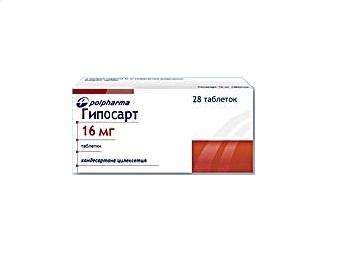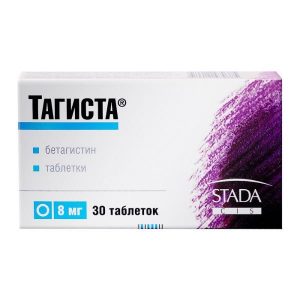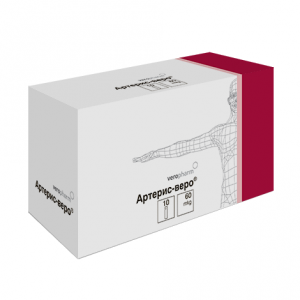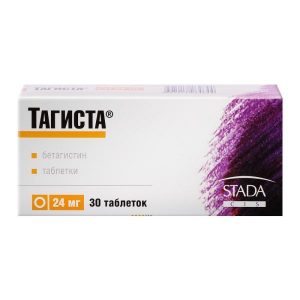Description
Latin name
HYPOSART
Release form
Tablets 16 mg.
Packing
Per pack 28 pcs.
The pharmacological effect of
Cmax in plasma is achieved within 3-4 hours. Plasma concentration increases linearly with increasing dose in the therapeutic interval (up to 32 mg). Vd – 0.13 L / kg. Plasma protein binding is 99.8%. Slightly metabolized in the liver (20-30%) with the participation of CYP2C with the formation of an inactive metabolite.
Final T1 / 2 – 9 hours. Does not cumulate. The total clearance is 0.37 ml / min / kg, while the renal clearance is about 0.19 ml / min / kg. Candesartan is excreted by the kidneys (by glomerular filtration and active tubular secretion): 26% – as candesartan and 7% – as an inactive metabolite with bile – 56% and 10%, respectively. After a single dose for 72 hours, more than 90% of the dose is excreted.
In elderly patients (over 65), Cmax and AUC increase by 50% and 80%, respectively, compared with younger patients.
In patients with mild to moderate renal impairment, Cmax and AUC increase by 50% and 70%, respectively, while T1 / 2 of the drug does not change compared with patients with normal renal function.
In patients with severely impaired renal function, Cmax and AUC increase by 50% and 110%, respectively, and T1 / 2 increases by 2 times.
In patients with mild to moderate hepatic impairment, an increase in AUC of 23% was observed.
Indications
– arterial hypertension
– chronic heart failure and impaired systolic function of the left ventricle (LVEF 40%) as adjunctive therapy for ACE inhibitors or for intolerance to ACE inhibitors.
Contraindications
– severe liver dysfunction and / or cholestasis
– simultaneous use with aliskiren and aliskiren-containing drugs in patients with diabetes mellitus or impaired renal function (GFR lactose intolerance, lactase deficiency, glucose-galactose malabsorption syndrome
– children and adolescents under 18 years of age (efficacy and safety have not been established)
– hypersensitivity to candesartan or other components of the drug.
With caution, a drug should be prescribed for severe renal impairment (CC
Use during pregnancy and lactation
Hyposart is contraindicated in pregnancy, as it has a direct effect on RAAS and can cause fetal development disorders (especially in the second and third trimesters of pregnancy) or have a negative effect on a newborn, up to a fatal outcome, if the drug was used during pregnancy.
It is known that treatment with angiotensin II receptor antagonists (ARA II) can cause impaired fetal development (impaired renal function, oligohydramnios, delayed ossification of the bones of the skull) and the development of complications in the newborn (renal failure, arterial hypotension, hyperkalemia). When establishing the fact of pregnancy, the Hyposart drug must be canceled as soon as possible.
When planning pregnancy, it is necessary to transfer the patient to adequate alternative therapy.
It is not known whether candesartan is excreted in breast milk, but it is known to pass into the milk of lactating rats.
During treatment with Hypososart, breast-feeding should be discontinued. Newborns whose mothers took Hyposart during pregnancy should be under close medical supervision because of the likelihood of developing hypotension.
Composition
1 tab.
candesartan tsileksetil 16 mg
Excipients: lactose monohydrate – 87 mg, corn starch – 20 mg, hyprolose (viscosity, water, 25 ° C (5%) 75-150 cps) – 2 mg, hyprolose (viscosity, water, 25 ° C (5%) 1500-3000 cps) – 2 mg, macrogol 6000 – 2.6 mg, magnesium stearate – 0.4 mg.
Dosage and administration
The drug is taken orally, 1 time / day, regardless of food intake.
Arterial hypertension
The recommended initial and maintenance dose of Hyposart is 8 mg 1 time / day. If necessary, the dose can be increased to 16 mg 1 time / day. The maximum antihypertensive effect is achieved within 4 weeks of therapy. The maximum daily dose is 32 mg 1 time / day.
If, against the background of the maximum daily dose, adequate control of blood pressure is not achieved, it is recommended to add a thiazide diuretic to the therapy (for example, hydrochlorothiazide). This can enhance the antihypertensive effect of the drug Hyposart.
In patients at risk of developing arterial hypotension (including patients with reduced BCC), therapy is recommended to be started with a dose of 4 mg.
In patients with mild and moderate renal impairment (CC 30-80 ml / min / 1.73 m2), including patients on hemodialysis, the initial dose of the drug is 4 mg. The dose should be titrated depending on the therapeutic effect. Clinical experience with the use of the drug in patients with severe renal impairment or end-stage renal failure (CC less than 15 ml / min) is limited.
The initial daily dose of the drug in patients with mild and moderate liver disease is 4 mg. Possible dose increase if necessary. There is no clinical experience with the use of the drug in patients with severe hepatic impairment and / or cholestasis.
Chronic heart failure
The recommended initial dose of Hyposart is 4 mg 1 time / day. An increase to the maximum daily dose of 32 mg 1 time / day or to the maximum tolerated dose is carried out by doubling the dose with an interval of at least 2 weeks.
Elderly patients and patients with impaired renal or hepatic function do not need to adjust the initial dose of the drug.
Safety and efficacy of Hyposart in children and adolescents under the age of 18 have not been established.
Concomitant therapy
Hyposart can be used simultaneously with other drugs for the treatment of heart failure, including ACE inhibitors, beta-blockers, diuretics, cardiac glycosides, or combinations of these drugs.
Side effects
Classification of the incidence of side effects: very often ( 1/10) often ( 1/100). Side effects of candesartan are mild and transient. The frequency of side effects does not depend on the dose of the drug and the age of the patient.
From the nervous system: often – dizziness, headache, weakness.
From the cardiovascular system: often – an excessive decrease in blood pressure.
From the respiratory system: often – respiratory infections, pharyngitis, rhinitis, cough.
From the digestive system: very rarely – nausea, increased activity of hepatic transaminases, impaired liver function or hepatitis.
From the urinary system: often – impaired renal function, including renal failure in susceptible patients.
From the musculoskeletal system: very rarely – back pain, arthralgia, myalgia.
From the hemopoietic system: very rarely – leukopenia, neutropenia, thrombocytopenia and agranulocytosis.
Laboratory indicators: very rarely – hyperkalemia, hyponatremia, an increase in the concentration of creatinine in the blood, hyperuricemia, a slight decrease in hemoglobin.
Allergic reactions: very rarely – angioedema, skin rash, itching, urticaria.
Other: exacerbation of the course of gout, flushing of the face.
Drug Interaction
The use of candesartan concurrently with drugs containing aliskiren is contraindicated in patients with diabetes mellitus or moderate and severe renal failure (GFR2).
Concomitant administration of candesartan with hydrochlorothiazide, warfarin, digoxin, oral contraceptives (ethinylestradiol / levonorgestrel), glibenclamide, nifedipine and enalapril of clinically relevant pharmacokinetic interaction has been studied.
Candesartan is slightly metabolized in the liver (by CYP2C9 isoenzyme). No effect on the CYP2C9 and CYP3A4 isoenzymes has been identified with respect to other cytochrome P450 isoenzymes currently unknown.
Hypotensives potentiate the antihypertensive effect of candesartan. Experience with the use of other drugs acting on RAAS shows that the concomitant use of the drug and potassium-sparing diuretics (spironolactone, eplerenone, triamterene, amiloride), potassium, potassium substitutes, or other agents capable of increasing the concentration of potassium in syrups for example, heparin), can lead to the development of hyperkalemia.
Transient increases in serum lithium concentrations and the development of toxic effects have been reported with the simultaneous use of lithium and ACE inhibitors. A similar effect is possible with the simultaneous use of lithium preparations and angiotensin II receptor antagonists, which requires periodic monitoring of serum lithium concentrations when combined with these drugs.
When APA II and NSAIDs are used concurrently, including selective COX-2 inhibitors and non-selective NSAIDs (eg, acetylsalicylic acid at a dose greater than 3 g / day), the antihypertensive effect of candesartan can be reduced.
Double RAAS blockade
As with ACE inhibitors, concomitant administration of ARA II and NSAIDs increases the risk of renal impairment, leading to the development of renal failure, leading to hyperkalemia in patients with impaired renal function. This combination should be used with caution, especially in elderly patients. All patients should receive sufficient fluid to monitor renal function at the beginning of therapy and thereafter.
Overdose
Symptoms: excessive blood pressure drop, dizziness, tachycardia. Some cases of overdose of the drug (up to 672 mg candesartan cilexetil), which resulted in recovery of patients without serious consequences, are described.
Treatment: with excessive decrease in blood pressure, the patient should be moved to a horizontal position with a low head, then – to carry out activities aimed at increasing BCC (introduction of 0.9% sodium chloride solution in / in). Sympathomimetic drugs may be prescribed if necessary. It is recommended to carry out symptomatic therapy under the control of vital functions of the body. Hemodialysis is ineffective.
Storage conditions
The drug should be stored out of the reach of children at a temperature not exceeding 25 ° C.
Expiration
2 years.
Deystvuyuschee substances
candesartan
Terms of delivery from pharmacies
Prescription
dosage form
dosage form
tablets
Polarma, Poland




